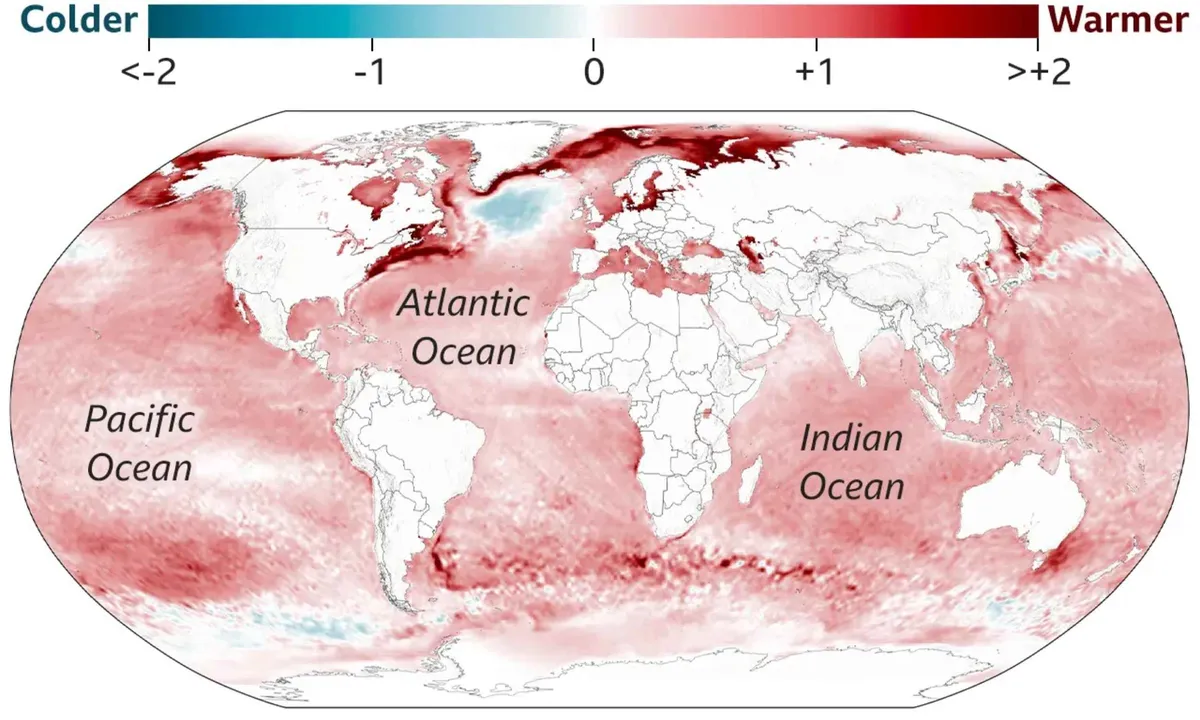
The world's oceans are absorbing more heat than ever before, with researchers indicating that these waters have gained warmth at an unprecedented rate. This significant shift not only impacts weather patterns but also affects marine life across the globe. A recent study examined global measurements from 2000 to 2023, drawing comparisons to conditions in the early 2000s. The findings highlight two specific latitudinal stretches near 40 degrees in both hemispheres where ocean temperatures are climbing notably.
Dr. Kevin Trenberth, a leading scientist from the University of Auckland and the National Center of Atmospheric Research (NCAR) in Boulder, Colorado, remarked, “It’s unusual to discover such a distinctive pattern jumping out from climate data.” This revelation underscores the urgency of understanding how rising ocean temperatures are reshaping our planet's climate.
Experts have been documenting rising ocean heat content for decades, as tracking this heat provides crucial insights into the planet’s changing climate. Over 90% of the extra warmth generated by human activity is stored in the oceans, making these bodies of water critical to understanding global warming. However, thermal changes do not distribute evenly; while certain latitudes are experiencing accelerated warming, others remain relatively stable.
The two fast-warming areas identified in the study are located around 40 degrees latitude in both the Northern and Southern Hemispheres. These regions extend from the North Atlantic, near the east coast of the United States, to waters near Japan, and from areas near New Zealand and Tasmania to the Atlantic east of Argentina. This spatial distribution aligns with shifts in wind patterns that follow the jet stream, a powerful current of winds moving from west to east. Furthermore, ocean currents have also adapted, redistributing heat differently than they have in the past.
The research team utilized temperature data from 1-degree latitude strips of ocean water extending to depths of 6,500 feet. They tracked changes from the year 2000 to 2023, using the early 2000s as a baseline for comparison. To quantify the warming, researchers employed zettajoules, a unit equivalent to one sextillion joules. This high-precision metric enabled them to detect subtle but significant shifts in ocean heat content, even at depths rarely measured by earlier technologies.
In addition to the mid-latitude bands, researchers also observed noticeable warming in the tropical regions between 10°N and 20°S. This warming covers a significant portion of the tropics; however, the changes were less consistent due to strong temperature swings caused by recurring El Niño and La Niña events. Despite this variability, the tropics continue to absorb substantial amounts of heat, which contributes to atmospheric moisture levels. This stored energy can subsequently impact rainfall patterns across distant regions through teleconnections, which are climate interactions that occur over thousands of miles.
Researchers have also noted that a poleward movement of storm tracks appears to coincide with the warming bands. Subtle changes in atmospheric circulation and winds have likely contributed to new pathways for heat transport. These altered wind patterns stir the sea surface and guide warm currents, allowing ocean heat to seep into deeper layers. This process adds to a chain reaction that impacts storms and rainfall.
Faster ocean heating can significantly influence the amount of water vapor in the atmosphere, subsequently intensifying conditions for heavier precipitation. This increase in moisture amplifies local rainfall, raising concerns about floods and more frequent storm events. Scientists stress the importance of considering natural variability when examining climate patterns. While human activity is the primary driver of long-term warming, regional ocean dynamics also play a crucial role.
Although human-caused climate change is the main factor behind rising ocean heat, researchers emphasize the significance of natural variability. Events such as the El Niño–Southern Oscillation can lead to short-term fluctuations that either amplify or temporarily mask the long-term warming signal. These overlapping influences complicate the interpretation of short-term data alone. Therefore, tracking trends across decades, as this study does, is essential for distinguishing persistent climate signals from temporary climate noise.
Sharp temperature changes in the ocean can disrupt marine ecosystems, leading to altered habitats and shifting species distributions. Warmer waters can interfere with feeding grounds and migration routes, significantly impacting fisheries and coastal economies. The new data underscore how various parts of the ocean can respond differently to warming, highlighting the importance of ongoing research to monitor changes and develop effective response strategies.
One unexpected finding from the study is the lack of substantial warming near 20 degrees latitude in both hemispheres. These subtropical regions have remained relatively stable in ocean heat content, standing out against the broader warming trend. Researchers suggest that ocean currents and atmospheric circulation may be bypassing these areas, causing them to act as transit zones where energy is redistributed rather than absorbed.
This groundbreaking study has been published in the Journal of Climate, shedding light on the urgent need for continued research into the implications of rising ocean temperatures on our planet.
—– Like what you read? Subscribe to our newsletter for engaging articles, exclusive content, and the latest updates. Check us out on EarthSnap, a free app brought to you by Eric Ralls and Earth.com. —–